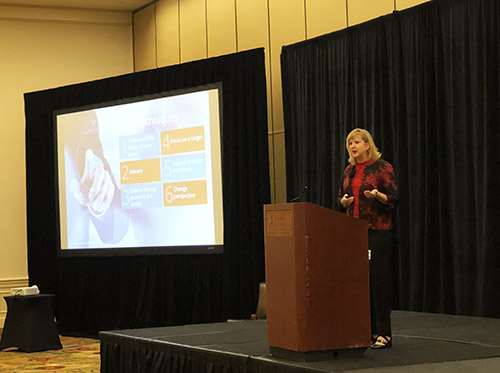 At this week’s AICD annual conference in San Antonio, Holly G. Green of The Human Factor Inc. gave a fascinating talk about our brains, and how we can retrain them to work better on the job. While the world has evolved at amazing speed over the last decade and the last century, our brains really haven’t. There’s an increasing disconnect with our brain versus the increasing pace of the world.
At this week’s AICD annual conference in San Antonio, Holly G. Green of The Human Factor Inc. gave a fascinating talk about our brains, and how we can retrain them to work better on the job. While the world has evolved at amazing speed over the last decade and the last century, our brains really haven’t. There’s an increasing disconnect with our brain versus the increasing pace of the world.
Central to understanding our brain is understanding that is really likes well-worn pathways. But, Green explained, the brain can learn new pathways, even in advanced age.
“There’sthat old cliché about how old dogs can’t learn new tricks. We’re not sure about dogs, but for humans, we do know that unless you’re dead or your brain is diseased, you can learn new tricks,” she said. “You can build new pathways. The problem is it requires a little bit of time, and it requires attention. And, at the pace we’re running today we don’t ever feel like we have that.”
Some interesting tidbits from her talk:
- Contrary to popular belief, we don’t use a mere 10% of our brains. Our brain does focus on about 10% of the incoming data—light, smell, sounds, etc.—to focus on and make inferences from. To prove her point, she had the attendees close their eyes and think about exactly what was on the walls of the ballroom they were seated in. Eyes opened a few moments later, she pointed out a multitude of objects and details that were clearly observable, but which our brains had chosen to ignore, out of a lack of importance.
- Our brains, which only weigh about three pounds, use up about 25% of our body’s energy. Green said to scheduleimportant work meeting early in the day or close a big deal early in the day, before our brains become more tired. “You definitely have decision fatigue in today’s world.”
- There is no such thing as multitasking in a human. Sometimes, what looks like multitasking is that you’re switching between tasks. You can do multiple rote behaviors at a time, but you can only do one thinking task at a time. “You’re switching back and forth, and each time takes a few seconds … start adding that up and imagine how many times you switch in a day. How much time are you actually wasting, by pretending to do more? It’s a fascinating thing, and something that gives worry to behavior scientists.”
- Green said one answer is to purposefully slow down. Take 30 seconds, at different times each day, to reset your brain. Clear your mind, ponder, wander, explore your thoughts. Ask yourself big questions, like, “What if my customers would like this now? I know two years ago they didn’t go for it, but what if today is the right time? What if I could join with a competitor on this, and we could offer a better solution that benefits each of us even more? What if?”
- Use future active past tense language, especially when setting goals. Success visioning, like Olympic athletes use, really works. Get crystal clear on your target—and imagine yourself there. Ask questions about who did, how did, what did, when did. Ask in the past tense, as if it’s already done.
- Make sure to constantly consume the big picture. What are the trends in today’s world? How can I take advantage of that? How can I carve out just enough time to visit a thought, to fill my brain with some really interesting stuff? You cannot connect dots if you haven’t gathered any dots first. And in today’s world we’ve stripped out the gathering of dots. Visit trend sites like nowandnext.com, globaltrends.com, trendwatching.com, burrus.com to help you think big picture.
Filed Under: News, Slider